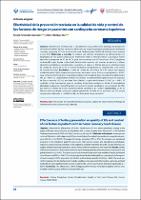Efectividad de la prevención terciaria en la calidad de vida y control de los factores de riesgo en pacientes con cardiopatía coronaria isquémica
Related Resource(s)
https://apcyccv.org.pe/index.php/apccc/article/view/323Date
2023-09-30Author(s)
Fernández Coronado, Rosalía
Olórtegui Yzu, Adriel
Metadata
Show full item recordAlternate title
Effectiveness of tertiary prevention on quality of life and control of risk factors in patients with ischemic coronary heart disease
Abstract
Objetivo. Determinar la efectividad de la rehabilitación cardiaca (RC) como estrategia de prevención terciaria en la calidad de vida y el control de factores de riesgo de pacientes portadores de cardiopatía coronaria isquémica (CCI) del Instituto Nacional Cardiovascular (INCOR) de EsSalud- Lima, durante el año 2018. Materiales y métodos. Se estudió una cohorte retrospectiva de 280 pacientes con diagnóstico de CCI quienes después del tratamiento médico, intervencionista o quirúrgico, fueron derivados al programa de RC de INCOR para prevención terciaria (PT) en el año 2018. El programa se desarrolló según la guía institucional, durante ocho semanas con sesiones de ejercicio y talleres educativos, psicológicos, nutricionales y recreativos. Al inicio y al final de este se les aplicó la prueba de calidad de vida QLMI-2 y se les realizó mediciones antropométricas, laboratoriales y de control de factores de riesgo. Resultados. El nivel de calidad de vida al final de la RC mostró una mejoría estadísticamente significativa en las dimensiones emocional, social, física y a nivel global (p < 0,001). Igual comportamiento se observó para las variables nutricionales de peso, circunferencia abdominal e IMC (p < 0,001). La capacidad física mostró una mejora estadísticamente significativa en los aspectos de fuerza muscular (12,2%), actividad física (38,0%) y capacidad funcional (25,4%) (p < 0,001). El resultado no fue homogéneo para las variables bioquímico-metabólicas, donde la hemoglobina glicosilada, la glicemia y el perfil lipídico no mostraron mejoría significativa, con excepción del HDL que elevó sus niveles de manera estadísticamente significativa (p < 0,001). Conclusiones. La RC es efectiva como estrategia central para realizar prevención terciaria en los pacientes con CCI ya que mejora ostensiblemente la calidad de vida y los factores de riesgo coronario.
Notes
Objective. Determine the effectiveness of cardiac rehabilitation (CR) as a tertiary prevention strategy in the quality of life and control of risk factors of patients with ischemic coronary heart disease (ICC) of the National Cardiovascular Institute (INCOR) of EsSalud- Lima during the year 2018. Materials and methods. A retrospective cohort of 280 patients with a diagnosis of CCI was studied who, after medical, interventional, or surgical treatment, were referred to the INCOR CR program for tertiary prevention (PT) in 2018. The program was developed according to the institutional guide for eight weeks with exercise sessions and educational, psychological, nutritional, and recreational workshops. At the beginning and at the end of this, the QLMI-2 quality of life test was applied, and anthropometric, laboratory, and risk factor control measurements were performed. Results. Quality of life levels at the end of CR showed a statistically significant improvement in the emotional, social, physical, and global dimensions (p < 0.001). The same behavior was observed for the nutritional variables of weight, abdominal circumference, and BMI (p < 0.001). Physical capacity showed a statistically significant improvement in the aspects of muscle strength (12.2%), physical activity (38.0%), and functional capability (25.4%) (p < 0.001). The result was not homogeneous for the biochemical metabolic variables, where glycosylated hemoglobin, glycemia, and lipid profile did not show significant improvement, except for HDL, which raised its levels statistically significantly (p < 0.001). Conclusions. CR is effective as a central strategy to perform tertiary prevention in patients with ICC since it notably improves quality of life and coronary risk factors.






